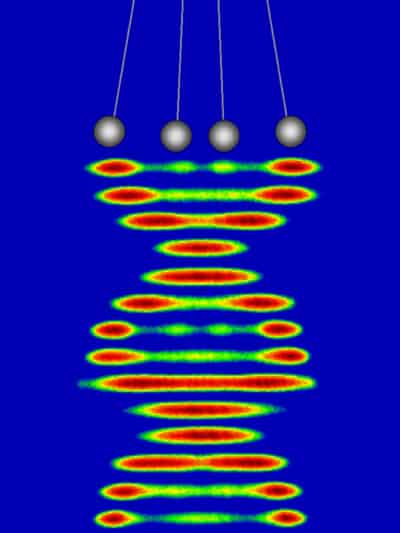Physicists in the US have made the first gas that never reaches equilibrium. David Weiss and colleagues at Penn State University performed their experiment with a one-dimensional Bose gas of ultracold rubidium atoms. According to the team, the gas behaves like a "quantum Newton's cradle" -- the atomic equivalent of the popular desk toy that has five steel balls suspended from strings in a straight line. The work could help us better understand the behaviour of many-particle systems and even be used in practical applications like ultrasenstive force detectors (Nature 440 900).

If you put two gases in a box, they will eventually become perfectly mixed as a result of the atoms colliding with each other. The system soon reaches its most probable state, which is called thermodynamic equilibrium. However, Weiss and co-workers have found that a gas in one dimension behaves differently and never reaches equilibrium.
Weiss’ team began by constructing a one-dimensional optical trap using interfering beams of laser light that form an array of thousands of parallel tube-shaped traps. Next, the physicists introduced an ultracold gas containing tens of thousands of rubidium atoms cooled to almost absolute zero into the trap. This ultracold is known as a Bose–Einstein condensate, in which all atoms enter the same quantum state.
Each tube contains about 150 atoms, which are forced to stay in one dimension because of the shape of the tube. The researchers then used other lasers to set the trapped atoms in motion so that they all oscillated with about the same amplitude. Although the atoms collided with each other, as happens in a normal gas, their distribution of momentum did not change. Instead, each atom continued oscillating with the same amplitude as at the start of the experiment — even after thousands of collisions.
According to the team, the system behaves like a quantum Newton’s cradle. In the classical version of this toy, a ball at one end can be made to hit the next ball in line, but only the last ball at the other end of the line moves; all the others stay still (figure 1). The quantum Newton’s cradle contains hundreds of atoms, not just five balls, and instead of always bouncing off each other, they often go right through each other, but the essential physics is the same. Another difference is that almost all of the atoms are oscillating at the beginning — something that can be done with a classical Newton’s cradle too (figure 2).
“Such striking behaviour, where the momentum values do not change even though momentum is exchanged among the balls, only occurs in one dimension,” explains Weiss. “Collisions between particles in two or three dimensions quickly result in the familiar homogenized state of thermal equilibrium.”
The study could shed more light on how thermodynamic equilibrium is reached in many-particle systems says Weiss. The one-dimensional trapped atoms could also be used a precise force sensors because they would not be limited in their sensitivity by collisions.
Weiss adds that that the new system is “integrable”, meaning that it can be described by equations of motion that predict its future when the equations are solved in one direction, and its past when they are solved in the opposite direction. “Only a handful of integrable many-body systems are known, and this is the first time that any of them has been observed experimentally,” he says.





